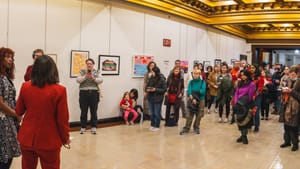Stay in the Loop
BSR publishes on a weekly schedule, with an email newsletter every Wednesday and Thursday morning. There’s no paywall, and subscribing is always free.
Arts supporters must raise their voice in every budget cycle
Does Philly’s proposed 2026 budget cut arts and culture? City arts leaders explain.

Each spring, we in the Philly arts and culture community steel ourselves to rally against perennial cuts in the mayor’s proposed budget. With the Philadelphia Citizen reporting in April that Mayor Parker’s Fiscal Year 2026 budget would cut arts and culture funding by almost 35 percent, a familiar dismay set in.
But the reality is more complicated, says chief cultural officer Val Gay, who helms Creative PHL (formerly the city’s Office of Arts, Culture, and the Creative Economy, as it still appears on the proposed budget). “It can be easy to get lost in the sauce,” she says.
Arts budget breakdown
For instance, the 2026 line showing a decrease of just over $8M for Creative PHL compared to FY25 on page 82 of the proposed budget isn’t really the cut that it looks like, Gay explains. Out of the $9,980,000 in the 2025 budget line, $5.5 million was a one-time grant from the city to the Philadelphia Cultural Fund (which operates under the Creative PHL umbrella). There was no expectation that it would be repeated in 2026. And a $2.6-million increase for 2025 was actually a one-time mid-year transfer of funds that just arrived this spring.
Gay says that mid-year transfer included $1.1 million for the completion of a statue honoring Philly civil rights activist Sadie Alexander (slated to go up at the end of next year) and $1.5 million for the Illuminate the Arts grant program.
That brought the total Creative PHL 2025 budget to just under $13 million, but because of the one-time Cultural Fund disbursement and the mid-year transfer, 2025 was an unusual year. This year’s proposed Creative PHL budget of just under $5.4 million actually does not reflect a cut from previous years. That $5.4 million covers $3.5 million for the Cultural Fund (BSR is a 2025 Cultural Fund grantee), $800,000 for the African American Museum in Philadelphia, and a little over $1 million to cover Creative PHL operations and salaries. But that doesn’t reflect the entirety of city arts funding: Mural Arts and the Philadelphia Museum of Art (PMA) have their own allocations, though Gay notes that Mural Arts is now technically under the umbrella of Creative PHL.
Not a simple calculus
Pinning down exactly how much of the city budget is going toward the arts is actually a difficult question, Gay says. Philly needs a dedicated funding source for arts and culture instead of a piecemeal year-to-year budget fight, but Gay maintains it’s “premature” to develop this without a clearer picture of all of the funding. To that end, Creative PHL is partnering with the Greater Philadelphia Cultural Alliance (GPCA).
“I think people want a simple calculus,” says GPCA president and CEO Patricia Wilson Aden, but it’s more difficult than that. Current arts funding is not limited to Creative PHL and institutions like the PMA. There are art activities within the Department of Recreation and within the Office of Clean and Green, for example. Gay and Aden say we need a centralized tally of these dollars and programs to take the next step in advocacy.
The arts are not a silo
They also argue that we need to stop seeing arts and culture as a silo that doesn’t connect to the rest of the city. “Our creative sector is an economic engine,” Aden says, with an annual impact of $3 billion. Our region’s heritage sites, including historic landmarks, world-famous green spaces, like Longwood Gardens, and the Philadelphia Zoo, are all part of Philly’s “magnet” for tourism and visitation. And arts and culture are inextricably linked with other industries, as ticket-buyers spend on hotel rooms, shopping, food, and transit or parking. Arts access also has a direct tie to educational attainment, especially for marginalized communities, Aden adds.
“We would hope that our partners in business, but also our elected officials, our civic leaders, come to appreciate the essential role that the creative economy plays in our larger ecosystem,” Aden says.
A long-term perspective
“This is a longitudinal issue,” Gay says: Philly’s arts-funding challenge has been decades in the making. She doesn’t think it will take decades to fix, “but it also won’t happen in one budget cycle.” She urges advocates to keep an eye on the big picture instead of just the immediate fight, and to be aware of the many outside forces beyond our local sector’s control.
Both Gay and Aden are all for increasing the existing arts budget, and they point out that a more consistent funding structure would increase organizations’ capacity. “So much of our energy is distracted by the advocacy fight,” Aden says. A future with a dedicated funding stream would mean “our activities could continue without disruption, and we would not be subject to and sometimes victimized by the will and whim of politicians.”
Mayor Parker’s office did not return a request for comment on this year’s proposed arts budget. Councilmember Rue Landau, who has signaled her support for the cultural sector, noted that arts and culture funding represents less than one percent of the city’s budget, despite being “crucial to Philadelphia’s economy, tourism, job creation, and cultural identity.”
A federal crisis
Chaotic cuts from the Trump Administration, including last week’s sweeping denial of promised NEA funding to organizations throughout the country, make the fight for our local arts budget even more urgent.
Aden says city funding should not be the backbone of cultural groups, all of whom need to diversify their budgets to survive, but as federal cuts bite deep, local organizations need a safety net. If this existed, “we wouldn’t have the degree of crisis that we’re having right now” because of federal cuts.
No time for arts lovers to be quiet
Gay likens the arts struggle to “fighting over the crumbs of a stale bagel” when “right behind us is a whole honking bakery … all we need to do is join arms, stand up, and storm the bakery.” As of early May, Philly’s FY26 budget is not yet finalized. Our advocacy matters.
Creative PHL is helming a series of public sessions to hear from residents of every neighborhood on a comprehensive plan for the sector. Find a meeting here and make your voice heard. Supporters of arts funding should get in regular contact with their city councilmembers by phone or email, and speak up at one of the two remaining 2026 budget hearings, scheduled for May 13 and 14. (Here’s more info.) As Gay puts it, we can remind our leaders that the arts and culture sector is “a formidable voting bloc.”
“It’s a time for us to be kind to one another, to lean on one another, but also to flex our power as a sector,” Aden concludes. “I think there’s intent to silence people, silence organizations, silence the sector. This is not a time to be quiet.”
Sign up for our newsletter
All of the week's new articles, all in one place. Sign up for the free weekly BSR newsletters, and don't miss a conversation.

 Alaina Johns
Alaina Johns